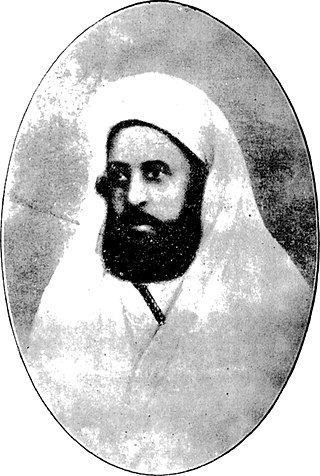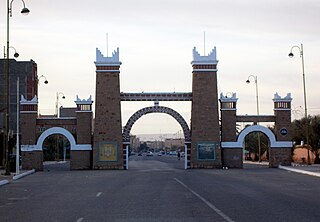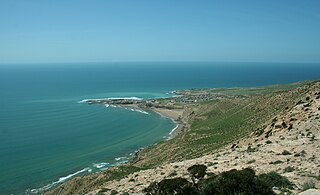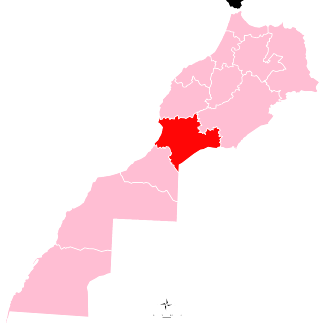| Paradise Valley | |
|---|---|
| Tamraght River Valley | |
 View of Paradise Valley | |
| Geography | |
| Coordinates | 30°35′22″N9°31′22″W / 30.58944°N 9.52278°W |
Paradise Valley is a section of the Tamraght River valley in the Moroccan High Atlas mountains. [1]
| Paradise Valley | |
|---|---|
| Tamraght River Valley | |
 View of Paradise Valley | |
| Geography | |
| Coordinates | 30°35′22″N9°31′22″W / 30.58944°N 9.52278°W |
Paradise Valley is a section of the Tamraght River valley in the Moroccan High Atlas mountains. [1]
The valley is named since it is often locally likened to a “paradise on earth”. It is also called Tamraght river valley after the name of the surrounding region. [2]
The valley is located approximately 35 km north of the city of Agadir. [3]
The valley is in the middle of the region of Imouzzar which is known for its broad biodiversity. It includes trees of palm, banana, olive and fig. The valley has numerous small waterfalls and cascades and rocky pools. [2]

Morocco is the northwesternmost country which spans from the Mediterranean Sea and Atlantic Ocean on the north and the west respectively, into large mountainous areas in the interior, to the Sahara desert in the far south. Morocco is a Northern African country, located in the extreme northwest of Africa on the edge of continental Europe. The Strait of Gibraltar separates Spain from Morocco with a 13 kilometres (8.1 mi) span of water. Morocco borders the North Atlantic Ocean to the west, and the western Mediterranean Sea to the north, and has borders with Algeria and disputed Western Sahara.

Marrakesh or Marrakech is the fourth largest city in Morocco. It is one of the four imperial cities of Morocco and the capital of the Marrakesh–Safi region. It is west of the foothills of the Atlas Mountains.

Agadir is a major city in Morocco, on the shore of the Atlantic Ocean near the foot of the Atlas Mountains, just north of the point where the Souss River flows into the ocean, and 509 kilometres (316 mi) south of Casablanca. Agadir is the capital of the Agadir Ida-U-Tanan Prefecture and of the Souss-Massa economic region.

The Agadir Crisis, Agadir Incident, or Second Moroccan Crisis was a brief crisis sparked by the deployment of a substantial force of French troops in the interior of Morocco in April 1911 and the deployment of the German gunboat SMS Panther to Agadir, a Moroccan Atlantic port. Germany did not object to France's expansion but wanted territorial compensation for itself. Berlin threatened warfare, sent a gunboat, and stirred up German nationalists. Negotiations between Berlin and Paris resolved the crisis on 4 November 1911: France took over Morocco as a protectorate in exchange for territorial concessions to German Cameroon from the French Congo.

Essaouira, known until the 1960s as Mogador, is a port city in the western Moroccan region of Marakesh-Safi, on the Atlantic coast. It has 77,966 inhabitants as of 2014.

MawlayHassan bin Mohammed, known as Hassan I, born in 1836 in Fes and died on 9 June 1894 in Tadla, was a sultan of Morocco from 12 September 1873 to 7 June 1894, as a ruler of the 'Alawi dynasty. He was proclaimed sultan after the death of his father Mawlay Muhammad bin Abd al-Rahman. Mawlay Hassan was among the most successful sultans. He increased the power of the makhzen in Morocco and at a time when so much of the rest of Africa was falling under foreign control, he brought in military and administrative reforms to strengthen the regime within its own territory, and he carried out an active military and diplomatic program on the periphery. He died on 9 June 1894 and was succeeded by his son Abd al-Aziz.

The Saadi Sultanate was a state which ruled present-day Morocco and parts of West Africa in the 16th and 17th centuries. It was led by the Saadi dynasty, an Arab Moroccan Sharifian dynasty.

Aït Benhaddou is a historic ighrem or ksar along the former caravan route between the Sahara and Marrakesh in Morocco. It is considered a great example of Moroccan earthen clay architecture and has been a UNESCO World Heritage Site since 1987.

Zagora is a town located in the Draa River valley in the Moroccan region of Drâa-Tafilalet.

Inezgane is the capital of Inezgane-Aït Melloul Prefecture located on the north bank of the Sous River, about 11.5 km (7.1 mi) south of Agadir, on the Atlantic Ocean coast of Morocco. It is in some ways a suburb to the larger Agadir, but unlike the tourism-centered Agadir, Inezgane is a typical Moroccan/Berber city. Located where the N1, N8 and N10 highways meet, Inezgane is an important transport hub in the region of Souss-Massa. The record of the highest temperarures in Inezgane, 51.7 °C, is disputed.

The 1960 Agadir earthquake occurred 29 February at 23:40 Western European Time near the city of Agadir, located in western Morocco on the shore of the Atlantic Ocean. Despite the earthquake's moderate Mw scale magnitude of 5.8, its relatively shallow depth (15.0 km) resulted in strong surface shaking, with a maximum perceived intensity of X (Extreme) on the Mercalli intensity scale. Between 12,000 and 15,000 people were killed and another 12,000 injured with at least 35,000 people left homeless, making it the most destructive and deadliest earthquake in Moroccan history. Particularly hard hit were Founty, the Kasbah, Yachech/Ihchach and the Talborjt area. The earthquake's shallow focus, close proximity to the port city of Agadir, and unsatisfactory construction methods were all reasons declared by earthquake engineers and seismologists as to why it was so destructive.

Taghazout is a small berber fishing village 19 km (12 mi) north of the city of Agadir in southwestern Morocco. The inhabitants are mostly of Berber origin. Fishing, tourism, and the production of Argan oil being the main source of income. In recent years, tourism has been increasing in importance to the local economy and it is a popular surfing destination.

Tourism in Morocco is well developed, maintaining a strong tourist industry focused on the country's coast, culture, and history. The Moroccan government created a Ministry of Tourism in 1985. Tourism is considered one of the main foreign exchange sources in Morocco and since 2013 it had the highest number of arrivals out of the countries in Africa. In 2018, 12.3 million tourists were reported to have visited Morocco.

Moroccan–Portuguese conflicts refer to a series of battles between Morocco and Portugal throughout history including Battle of Tangier, Fall of Agadir and other battles and sieges in the Moroccan coast.

The French conquest of Morocco began in 1907 and continued until 1934. By the Treaty of Fez of 1912, France imposed a protectorate over Morocco and spent the next two decades taking control of the country.

Morocco–Portugal relations cover a period of several centuries largely historic, and to present not particularly substantial relations. Initial contacts started in the 8th century, when Muslim forces invaded most of the territory of the Iberian peninsula. After the Reconquista, Portugal would then expand into Africa, starting with the territory of Morocco, by invading cities and establishing fortified outposts along the Moroccan coast.

Imsouane is a small town and rural commune in Agadir-Ida Ou Tanane Prefecture, Souss-Massa, Morocco. At the time of the 2004 census, the commune had a total population of 9353 people living in 1704 households.

Souss-Massa is one of the twelve regions of Morocco. It covers an area of 51,642 km² and had a population of 2,676,847 as of the 2014 Moroccan census. The capital of the region is Agadir.

An agadir is a fortified communal granary found in the Maghreb.

Surfing in Morocco forms a part of the country's tourism sector.